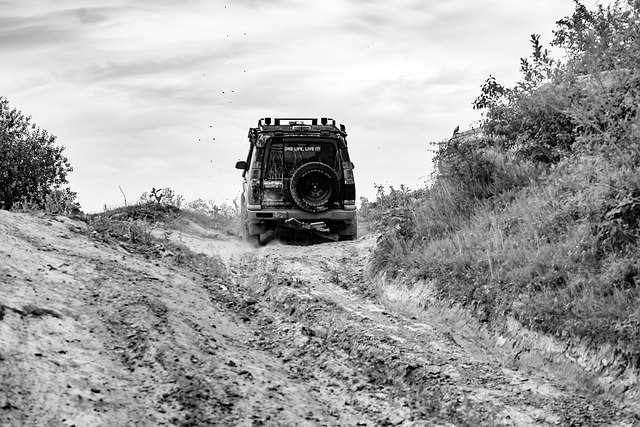Brownsville Off Road Communities prioritize safety through rigorous vehicle inspections and strict maintenance guidelines. Locals ensure off-road vehicles are fit for the diverse terrain by checking essential components like brakes, lights, tires, and safety gear. Comprehensive inspections include mechanical systems, suspension, and traction, addressing unique challenges of remote areas. Training sessions, mobile repair kits, and technology enhance communities' ability to perform basic diagnostics, improving safety and accessibility during off-road adventures in Brownsville.
Brownville, with its diverse off-road communities, demands a deep understanding of vehicle safety standards. This article explores the critical aspects of inspecting and diagnosing off-road vehicles, ensuring their reliability in remote areas. We delve into the key components of comprehensive inspections and address common challenges faced by residents. By highlighting best practices, we empower Brownsville folks to maintain safe and efficient off-road transportation, tailored to their unique landscape.
- Understanding Off-Road Vehicle Safety Standards in Brownsville Communities
- Key Components of an Effective Off-Road Vehicle Inspection
- Common Diagnostic Challenges and Solutions for Off-Road Vehicles in Remote Areas
Understanding Off-Road Vehicle Safety Standards in Brownsville Communities
In Brownsville communities, off-road vehicle safety is a critical aspect that often goes hand in hand with the region’s unique terrain and outdoor lifestyle. These vehicles, designed for rugged and off-the-beaten-path adventures, must adhere to specific safety standards to protect both operators and other users of these trails and paths. Understanding these standards is essential for anyone venturing into Brownsville’s vast off-road network.
Brownsville Off Road Communities prioritize safety through regular inspections and adherence to established guidelines. This includes ensuring proper functioning of brakes, lights, and indicators, as well as maintaining adequate tire condition and pressure. Additionally, off-road vehicles should be equipped with necessary safety gear, such as sturdy seats and safety belts, to minimize risks during unexpected terrain changes or accidents. By adhering to these standards, Brownsville residents and visitors can enjoy their outdoor adventures while minimizing potential hazards associated with off-road driving.
Key Components of an Effective Off-Road Vehicle Inspection
When conducting an inspection for off-road vehicles, particularly in the dynamic environment of Brownsville Off Road Communities, several key components must be thoroughly evaluated to ensure safety and optimal performance. The first step is a meticulous examination of the vehicle’s mechanical systems, including the engine, transmission, differential, and drivetrain. These parts are pivotal for navigating challenging terrains, so any wear, tear, or malfunction can severely impact off-road capabilities.
Additionally, inspecting the suspension system, tires, and brakes is paramount. The suspension absorbs shocks and enables smooth navigation over uneven surfaces, while robust tires with suitable tread patterns provide traction on diverse terrain. Efficient brakes are essential for controlled descents and sudden stops during adventurous off-road drives in Brownsville’s rugged landscapes.
Common Diagnostic Challenges and Solutions for Off-Road Vehicles in Remote Areas
In remote areas, diagnosing and inspecting off-road vehicles presents unique challenges due to limited access to specialized equipment and skilled mechanics. One of the primary difficulties is identifying issues that may not be immediately apparent during visual inspections. For instance, problems with drivetrain components, such as differential leaks or worn bearings, can be hard to detect without advanced diagnostic tools. However, these challenges can be mitigated by empowering local off-road communities in Brownsville with basic troubleshooting knowledge. Workshops and training sessions focused on common issues specific to off-road vehicles can equip community members to perform initial checks and identify red flags.
Another solution is establishing mobile repair kits equipped with essential tools and parts tailored for off-road vehicles. These kits could be shared among community members, enabling efficient problem-solving and repairs in remote locations. Additionally, leveraging technology like smartphone apps for diagnostics and online forums dedicated to off-road enthusiasts can facilitate knowledge sharing and remote assistance. Such initiatives ensure that Brownsville’s off-road communities are better equipped to handle basic inspections and diagnoses, enhancing safety and accessibility during their adventurous expeditions.
In conclusion, ensuring safe off-road vehicle operation in Brownsville communities requires a comprehensive understanding of safety standards and effective inspection practices. By focusing on key components and addressing common diagnostic challenges, we can enhance vehicle reliability and safety in these remote areas. This, in turn, fosters a more secure and enjoyable off-road experience for all residents and visitors alike in the vibrant Brownsville Off Road Communities.
